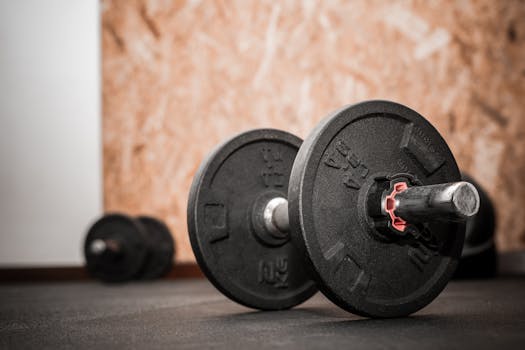
High-Intensity Interval Training (HIIT) for Fat Loss: A Comprehensive Guide
High-intensity interval training (HIIT) for fat loss is a type of workout that involves short bursts of high-intensity exercise followed by brief periods of rest. This type of training has gained popularity in recent years due to its effectiveness in burning fat and improving cardiovascular health.
What is HIIT?
HIIT involves short periods of high-intensity exercise, typically lasting between 15-60 seconds, followed by periods of rest or low-intensity exercise. This cycle is repeated for a duration of 15-30 minutes, depending on the specific workout. The high-intensity periods are designed to push your body to its limits, while the rest periods allow you to recover and prepare for the next burst of exercise.
Benefits of HIIT for Fat Loss
HIT has several benefits that make it an effective way to lose fat. Some of the benefits include:
- Increased Caloric Burn: HIIT workouts are designed to be high-intensity, which means they burn a high number of calories both during and after the workout.
- Improved Insulin Sensitivity: HIIT has been shown to improve insulin sensitivity, which can help reduce the risk of developing type 2 diabetes.
- Enhanced Cardiovascular Health: HIIT workouts are designed to push your cardiovascular system to its limits, which can help improve heart health and reduce the risk of cardiovascular disease.
- Time-Efficient: HIIT workouts are typically short, lasting between 15-30 minutes, making them a great option for those with busy schedules.
How to Incorporate HIIT into Your Workout Routine
Incorporating HIIT into your workout routine can be simple. Here are some tips to get you started:
- Start with Short Workouts: Begin with short workouts, such as 15-20 minutes, and gradually increase the duration as you become more comfortable with the format.
- Choose High-Intensity Exercises: Choose exercises that are high-intensity, such as sprints, burpees, or jump squats.
- Incorporate Rest Periods: Make sure to incorporate rest periods between bursts of exercise. This will allow your body to recover and prepare for the next burst of exercise.
- Listen to Your Body: Listen to your body and only do what feels comfortable and safe. If you’re new to HIIT, it’s best to start with shorter workouts and gradually increase the intensity and duration.
Example HIIT Workouts
Here are some example HIIT workouts to get you started:
- Sprints: Sprint for 30 seconds, followed by 30 seconds of rest. Repeat for 15-20 minutes.
- Burpees: Do 10 burpees, followed by 30 seconds of rest. Repeat for 15-20 minutes.
- Jump Squats: Do 20 jump squats, followed by 30 seconds of rest. Repeat for 15-20 minutes.
Conclusion
High-intensity interval training (HIIT) is a highly effective way to lose fat and improve cardiovascular health. By incorporating HIIT into your workout routine, you can burn calories, improve insulin sensitivity, and enhance your overall health and well-being. Remember to start with short workouts, choose high-intensity exercises, incorporate rest periods, and listen to your body. With consistent practice and patience, you can achieve your fitness goals and enjoy the many benefits of HIIT.
Additional Tips
In addition to the benefits and workout tips outlined above, here are some additional tips to keep in mind when doing HIIT workouts:
- Warm Up: Always warm up before starting a HIIT workout. This can include light cardio, such as jogging or jumping jacks, and dynamic stretching, such as leg swings and arm circles.
- Stay Hydrated: Make sure to stay hydrated before, during, and after your HIIT workout. This can include drinking water or a sports drink.
- Listen to Music: Listening to music can help motivate you and increase your intensity during a HIIT workout.
Common Mistakes to Avoid
Here are some common mistakes to avoid when doing HIIT workouts:
- Not Warming Up: Not warming up before a HIIT workout can increase your risk of injury.
- Not Listening to Your Body: Not listening to your body and pushing yourself too hard can lead to injury or burnout.
- Not Incorporating Rest Periods: Not incorporating rest periods can lead to overtraining and decreased performance.
HIIT for Beginners
If you’re new to HIIT, it’s best to start with shorter workouts and gradually increase the intensity and duration. Here are some tips for beginners:
- Start with Short Workouts: Begin with short workouts, such as 10-15 minutes, and gradually increase the duration as you become more comfortable with the format.
- Choose Low-Impact Exercises: Choose low-impact exercises, such as walking or jogging, to reduce your risk of injury.
- Listen to Your Body: Listen to your body and only do what feels comfortable and safe.
Advanced HIIT Workouts
If you’re looking to take your HIIT workouts to the next level, here are some advanced techniques to try:
- Increase the Intensity: Increase the intensity of your workouts by adding more exercises, increasing the duration of your workouts, or decreasing your rest periods.
- Try New Exercises: Try new exercises, such as jump squats or burpees, to challenge yourself and keep your workouts interesting.
- Incorporate Strength Training: Incorporate strength training into your HIIT workouts to build muscle and increase your metabolism.
HIIT and Nutrition
Proper nutrition is essential for getting the most out of your HIIT workouts. Here are some tips for fueling your body:
- Eat a Balanced Diet: Eat a balanced diet that includes plenty of fruits, vegetables, whole grains, and lean protein sources.
- Stay Hydrated
Conclusion
In conclusion, High-Intensity Interval Training (HIIT) is a highly effective way to lose fat and improve cardiovascular health. By incorporating HIIT into your workout routine, you can burn calories, improve insulin sensitivity, and enhance your overall health and well-being. Remember to start with short workouts, choose high-intensity exercises, incorporate rest periods, and listen to your body. With consistent practice and patience, you can achieve your fitness goals and enjoy the many benefits of HIIT.




